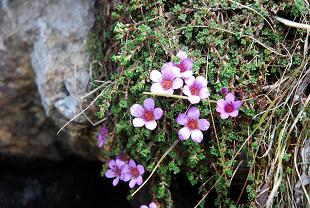
Saxifrage growing at Ben Lawers
The major piece of landscape restoration by the National Trust for Scotland (NTS) started in autumn 2010 with the removal of the old 1970s visitor centre and car park. The site has since been reinstated to moorland, with a new car park placed in a less visible site within a woodland setting. New unmanned outdoor interpretation has also been created to tell the unique stories of the reserve and to provoke visitors to think about the significance of the site.
Ben Lawers NNR has been in the care of the National Trust for Scotland since 1950. It is a Site of Special Scientific Interest (SSSI) and a Special Area of Conservation under the European Habitats Directive for the exceptional examples of a number of habitats, rare on a European scale. Scotland’s tenth highest mountain, is widely known for its outstanding range and diversity of arctic-alpine species and vegetation types. It is important for the very large number of nationally rare or scarce montane plant species that it supports, including vascular plants, lichens, and bryophytes. It also has an outstanding diversity of invertebrates with many nationally rare or notable species.
As well as the starting point for walks up Ben Lawers itself and the neighbouring Tarmachan Ridge there is the shorter Ben Lawers Nature Trail, suitable for a gentle ramble or family outing while still giving the opportunity to view the mid-level alpine habitat that makes the area so special.
